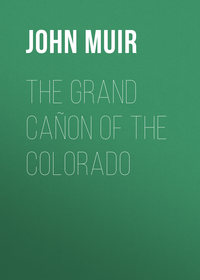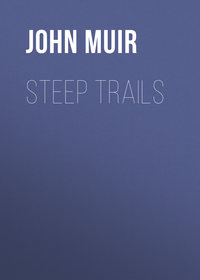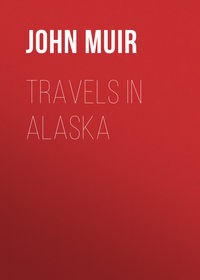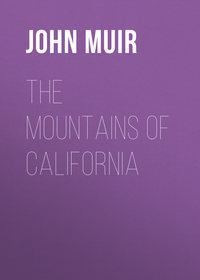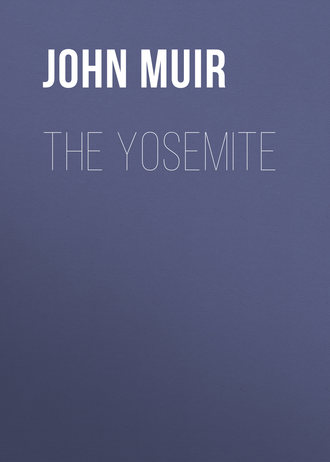 полная версия
полная версияThe Yosemite
Avalanches
Besides these common after-storm avalanches that are to be found not only in the Yosemite but in all the deep, sheer-walled cañon of the Range there are two other important kinds, which may be called annual and century avalanches, which still further enrich the scenery. The only place about the Valley where one may be sure to see the annual kind is on the north slope of Clouds' Rest. They are composed of heavy, compacted snow, which has been subjected to frequent alternations of freezing and thawing. They are developed on cañon and mountain-sides at an elevation of from nine to ten thousand feet, where the slopes are inclined at an angle too low to shed off the dry winter snow, and which accumulates until the spring thaws sap their foundations and make them slippery; then away in grand style go the ponderous icy masses without any fine snow-dust. Those of Clouds' Rest descend like thunderbolts for more than a mile.
The great century avalanches and the kind that mow wide swaths through the upper forests occur on mountain-sides about ten or twelve thousand feet high, where under ordinary weather conditions the snow accumulated from winter to winter lies at rest for many years, allowing trees, fifty to a hundred feet high, to grow undisturbed on the slopes beneath them. On their way down through the woods they seldom fail to make a perfectly clean sweep, stripping off the soil as well as the trees, clearing paths two or three hundred yards wide from the timber line to the glacier meadows or lakes, and piling their uprooted trees, head downward, in rows along the sides of the gaps like lateral moraines. Scars and broken branches of the trees standing on the sides of the gaps record the depth of the overwhelming flood; and when we come to count the annual wood-rings on the uprooted trees we learn that some of these immense avalanches occur only once in a century or even at still wider intervals.
A Ride On An Avalanche
Few Yosemite visitors ever see snow avalanches and fewer still know the exhilaration of riding on them. In all my mountaineering I have enjoyed only one avalanche ride, and the start was so sudden and the end came so soon I had but little time to think of the danger that attends this sort of travel, though at such times one thinks fast. One fine Yosemite morning after a heavy snowfall, being eager to see as many avalanches as possible and wide views of the forest and summit peaks in their new white robes before the sunshine had time to change them, I set out early to climb by a side cañon to the top of a commanding ridge a little over three thousand feet above the Valley. On account of the looseness of the snow that blocked the cañon I knew the climb would require a long time, some three or four hours as I estimated; but it proved far more difficult than I had anticipated. Most of the way I sank waist deep, almost out of sight in some places. After spending the whole day to within half an hour or so of sundown, I was still several hundred feet below the summit. Then my hopes were reduced to getting up in time to see the sunset. But I was not to get summit views of any sort that day, for deep trampling near the cañon head, where the snow was strained, started an avalanche, and I was swished down to the foot of the cañon as if by enchantment. The wallowing ascent had taken nearly all day, the descent only about a minute. When the avalanche started I threw myself on my back and spread my arms to try to keep from sinking. Fortunately, though the grade of the cañon is very steep, it is not interrupted by precipices large enough to cause outbounding or free plunging. On no part of the rush was I buried. I was only moderately imbedded on the surface or at times a little below it, and covered with a veil of back-streaming dust particles; and as the whole mass beneath and about me joined in the flight there was no friction, though I was tossed here and there and lurched from side to side. When the avalanche swedged and came to rest I found myself on top of the crumpled pile without bruise or scar. This was a fine experience. Hawthorne says somewhere that steam has spiritualized travel; though unspiritual smells, smoke, etc., still attend steam travel. This flight in what might be called a milky way of snow-stars was the most spiritual and exhilarating of all the modes of motion I have ever experienced. Elijah's flight in a chariot of fire could hardly have been more gloriously exciting.
The Streams In Other Seasons
In the spring, after all the avalanches are down and the snow is melting fast, then all the Yosemite streams, from their fountains to their falls, sing their grandest songs. Countless rills make haste to the rivers, running and singing soon after sunrise, louder and louder with increasing volume until sundown; then they gradually fail through the frosty hours of the night. In this way the volume of the upper branches of the river is nearly doubled during the day, rising and falling as regularly as the tides of the sea. Then the Merced overflows its banks, flooding the meadows, sometimes almost from wall to wall in some places, beginning to rise towards sundown just when the streams on the fountains are beginning to diminish, the difference in time of the daily rise and fall being caused by the distance the upper flood streams have to travel before reaching the Valley. In the warmest weather they seem fairly to shout for joy and clash their upleaping waters together like clapping of hands; racing down the cañons with white manes flying in glorious exuberance of strength, compelling huge, sleeping boulders to wake up and join in their dance and song, to swell their exulting chorus.
In early summer, after the flood season, the Yosemite streams are in their prime, running crystal clear, deep and full but not overflowing their banks–about as deep through the night as the day, the difference in volume so marked in spring being now too slight to be noticed. Nearly all the weather is cloudless and everything is at its brightest–lake, river, garden and forest with all their life. Most of the plants are in full flower. The blessed ouzels have built their mossy huts and are now singing their best songs with the streams.
In tranquil, mellow autumn, when the year's work is about done and the fruits are ripe, birds and seeds out of their nests, and all the landscape is glowing like a benevolent countenance, then the streams are at their lowest ebb, with scarce a memory left of their wild spring floods. The small tributaries that do not reach back to the lasting snow fountains of the summit peaks shrink to whispering, tinkling currents. After the snow is gone from the basins, excepting occasional thundershowers, they are now fed only by small springs whose waters are mostly evaporated in passing over miles of warm pavements, and in feeling their way slowly from pool to pool through the midst of boulders and sand. Even the main rivers are so low they may easily be forded, and their grand falls and cascades, now gentle and approachable, have waned to sheets of embroidery.
Chapter 4
Snow Banners
But it is on the mountain tops, when they are laden with loose, dry snow and swept by a gale from the north, that the most magnificent storm scenery is displayed. The peaks along the axis of the Range are then decorated with resplendent banners, some of them more than a mile long, shining, streaming, waving with solemn exuberant enthusiasm as if celebrating some surpassingly glorious event.
The snow of which these banners are made falls on the high Sierra in most extravagant abundance, sometimes to a depth of fifteen or twenty feet, coming from the fertile clouds not in large angled flakes such as one oftentimes sees in Yosemite, seldom even in complete crystals, for many of the starry blossoms fall before they are ripe, while most of those that attain perfect development as six-petaled flowers are more or less broken by glinting and chafing against one another on the way down to their work. This dry frosty snow is prepared for the grand banner-waving celebrations by the action of the wind. Instead of at once finding rest like that which falls into the tranquil depths of the forest, it is shoved and rolled and beaten against boulders and out-jutting rocks, swirled in pits and hollows like sand in river pot-holes, and ground into sparkling dust. And when storm winds find this snow-dust in a loose condition on the slopes above the timber-line they toss it back into the sky and sweep it onward from peak to peak in the form of smooth regular banners, or in cloudy drifts, according to the velocity and direction of the wind, and the conformation of the slopes over which it is driven. While thus flying through the air a small portion escapes from the mountains to the sky as vapor; but far the greater part is at length locked fast in bossy overcurling cornices along the ridges, or in stratified sheets in the glacier cirques, some of it to replenish the small residual glaciers and remain silent and rigid for centuries before it is finally melted and sent singing down home to the sea.
But, though snow-dust and storm-winds abound on the mountains, regular shapely banners are, for causes we shall presently see, seldom produced. During the five winters that I spent in Yosemite I made many excursions to high points above the walls in all kinds of weather to see what was going on outside; from all my lofty outlooks I saw only one banner-storm that seemed in every way perfect. This was in the winter of 1873, when the snow-laden peaks were swept by a powerful norther. I was awakened early in the morning by a wild storm-wind and of course I had to make haste to the middle of the Valley to enjoy it. Rugged torrents and avalanches from the main wind-flood overhead were roaring down the side cañons and over the cliffs, arousing the rocks and the trees and the streams alike into glorious hurrahing enthusiasm, shaking the whole Valley into one huge song. Yet inconceivable as it must seem even to those who love all Nature's wildness, the storm was telling its story on the mountains in still grander characters.
A Wonderful Winter Scene
I had long been anxious to study some points in the structure of the ice-hill at the foot of the Upper Yosemite Fall, but, as I have already explained, blinding spray had hitherto prevented me from getting sufficiently near it. This morning the entire body of the Fall was oftentimes torn into gauzy strips and blown horizontally along the face of the cliff, leaving the ice-hill dry; and while making my way to the top of Fern Ledge to seize so favorable an opportunity to look down its throat, the peaks of the Merced group came in sight over the shoulder of the South Dome, each waving a white glowing banner against the dark blue sky, as regular in form and firm and fine in texture as if it were made of silk. So rare and splendid a picture, of course, smothered everything else and I at once began to scramble and wallow up the snow-choked Indian Cañon to a ridge about 8000 feet high, commanding a general view of the main summits along the axis of the Range, feeling assured I should find them bannered still more gloriously; nor was I in the least disappointed. I reached the top of the ridge in four or five hours, and through an opening in the woods the most imposing wind-storm effect I ever beheld came full in sight; unnumbered mountains rising sharply into the cloudless sky, their bases solid white their sides plashed with snow, like ocean rocks with foam, and on every summit a magnificent silvery banner, from two thousand to six thousand feet in length, slender at the point of attachment, and widening gradually until about a thousand or fifteen hundred feet in breadth, and as shapely and as substantial looking in texture as the banners of the finest silk, all streaming and waving free and clear in the sun-glow with nothing to blur the sublime picture they made.
Fancy yourself standing beside me on this Yosemite Ridge. There is a strange garish glitter in the air and the gale drives wildly overhead, but you feel nothing of its violence, for you are looking out through a sheltered opening in the woods, as through a window. In the immediate foreground there is a forest of silver fir their foliage warm yellow-green, and the snow beneath them strewn with their plumes, plucked off by the storm; and beyond broad, ridgy, cañon-furrowed, dome-dotted middle ground, darkened here and there with belts of pines, you behold the lofty snow laden mountains in glorious array, waving their banners with jubilant enthusiasm as if shouting aloud for joy. They are twenty miles away, but you would not wish them nearer, for every feature is distinct and the whole wonderful show is seen in its right proportions, like a painting on the sky.
And now after this general view, mark how sharply the ribs and buttresses and summits of the mountains are defined, excepting the portions veiled by the banners; how gracefully and nobly the banners are waving in accord with the throbbing of the wind flood; how trimly each is attached to the very summit of its peak like a streamer at a mast-head; how bright and glowing white they are, and how finely their fading fringes are penciled on the sky! See how solid white and opaque they are at the point of attachment and how filmy and translucent toward the end, so that the parts of the peaks past which they are streaming look dim as if seen through a veil of ground glass. And see how some of the longest of the banners on the highest peaks are streaming perfectly free from peak to peak across intervening notches or passes, while others overlap and partly hide one another.
As to their formation, we find that the main causes of the wondrous beauty and perfection of those we are looking at are the favorable direction and force of the wind, the abundance of snow-dust, and the form of the north sides of the peaks. In general, the north sides are concave in both their horizontal and vertical sections, having been sculptured into this shape by the residual glaciers that lingered in the protecting northern shadows, while the sun-beaten south sides, having never been subjected to this kind of glaciation, are convex or irregular. It is essential, therefore, not only that the wind should move with great velocity and steadiness to supply a sufficiently copious and continuous stream of snow-dust, but that it should come from the north. No perfect banner is ever hung on the Sierra peaks by the south wind. Had the gale today blown from the south, leaving the other conditions unchanged, only swirling, interfering, cloudy drifts would have been produced; for the snow, instead of being spouted straight up and over the tops of the peaks in condensed currents to be drawn out as streamers, would have been driven over the convex southern slopes from peak to peak like white pearly fog.
It appears, therefore, that shadows in great part determine not only the forms of lofty ice mountains, but also those of the snow banners that the wild winds hang upon them.
Earthquake Storms
The avalanche taluses, leaning against the walls at intervals of a mile or two, are among the most striking and interesting of the secondary features of the Valley. They are from about three to five hundred feet high, made up of huge, angular, well-preserved, unshifting boulders, and instead of being slowly weathered from the cliffs like ordinary taluses, they were all formed suddenly and simultaneously by a great earthquake that occurred at least three centuries ago. And though thus hurled into existence in a few seconds or minutes, they are the least changeable of all the Sierra soil-beds. Excepting those which were launched directly into the channels of swift rivers, scarcely one of their wedged and interlacing boulders has moved since the day of their creation; and though mostly made up of huge blocks of granite, many of them from ten to fifty feet cube, weighing thousands of tons with only a few small chips, trees and shrubs make out to live and thrive on them and even delicate herbaceous plants–draperia, collomia, zauschneria, etc., soothing and coloring their wild rugged slopes with gardens and groves.
I was long in doubt on some points concerning the origin of those taluses. Plainly enough they were derived from the cliffs above them, because they are of the size of scars on the wall, the rough angular surface of which contrasts with the rounded, glaciated, unfractured parts. It was plain, too, that instead of being made up of material slowly and gradually weathered from the cliffs like ordinary taluses, almost every one of them had been formed suddenly in a single avalanche, and had not been increased in size during the last three or four centuries, for trees three or four hundred years old are growing on them, some standing at the top close to the wall without a bruise or broken branch, showing that scarcely a single boulder had ever fallen among them. Furthermore, all these taluses throughout the Range seemed by the trees and lichens growing on them to be of the same age. All the phenomena thus pointed straight to a grand ancient earthquake. But for years I left the question open, and went on from cañon to cañon, observing again and again; measuring the heights of taluses throughout the Range on both flanks, and the variations in the angles of their surface slopes; studying the way their boulders had been assorted and related and brought to rest, and their correspondence in size with the cleavage joints of the cliffs from whence they were derived, cautious about making up my mind. But at last all doubt as to their formation vanished.
At half-past two o'clock of a moonlit morning in March, I was awakened by a tremendous earthquake, and though I had never before enjoyed a storm of this sort, the strange thrilling motion could not be mistaken, and I ran out of my cabin, both glad and frightened, shouting, "A noble earthquake! A noble earthquake!" feeling sure I was going to learn something. The shocks were so violent and varied, and succeeded one another so closely, that I had to balance myself carefully in walking as if on the deck of a ship among waves, and it seemed impossible that the high cliffs of the Valley could escape being shattered. In particular, I feared that the sheer-fronted Sentinel Rock, towering above my cabin, would be shaken down, and I took shelter back of a large yellow pine, hoping that it might protect me from at least the smaller outbounding boulders. For a minute or two the shocks became more and more violent–flashing horizontal thrusts mixed with a few twists and battering, explosive, upheaving jolts,–as if Nature were wrecking her Yosemite temple, and getting ready to build a still better one.
I was now convinced before a single boulder had fallen that earthquakes were the talus-makers and positive proof soon came. It was a calm moonlight night, and no sound was heard for the first minute or so, save low, muffled, underground, bubbling rumblings, and the whispering and rustling of the agitated trees, as if Nature were holding her breath. Then, suddenly, out of the strange silence and strange motion there came a tremendous roar. The Eagle Rock on the south wall, about a half a mile up the Valley, gave way and I saw it falling in thousands of the great boulders I had so long been studying, pouring to the Valley floor in a free curve luminous from friction, making a terribly sublime spectacle–an arc of glowing, passionate fire, fifteen hundred feet span, as true in form and as serene in beauty as a rainbow in the midst of the stupendous, roaring rock-storm. The sound was so tremendously deep and broad and earnest, the whole earth like a living creature seemed to have at last found a voice and to be calling to her sister planets. In trying to tell something of the size of this awful sound it seems to me that if all the thunder of all the storms I had ever heard were condensed into one roar it would not equal this rock-roar at the birth of a mountain talus. Think, then, of the roar that arose to heaven at the simultaneous birth of all the thousands of ancient cañon-taluses throughout the length and breadth of the Range!
The first severe shocks were soon over, and eager to examine the new-born talus I ran up the Valley in the moonlight and climbed upon it before the huge blocks, after their fiery flight, had come to complete rest. They were slowly settling into their places, chafing, grating against one another, groaning, and whispering; but no motion was visible except in a stream of small fragments pattering down the face of the cliff. A cloud of dust particles, lighted by the moon, floated out across the whole breadth of the Valley, forming a ceiling that lasted until after sunrise, and the air was filled with the odor of crushed Douglas spruces from a grove that had been mowed down and mashed like weeds.
After the ground began to calm I ran across the meadow to the river to see in what direction it was flowing and was glad to find that down the Valley was still down. Its waters were muddy from portions of its banks having given way, but it was flowing around its curves and over its ripples and shallows with ordinary tones and gestures. The mud would soon be cleared away and the raw slips on the banks would be the only visible record of the shaking it suffered.
The Upper Yosemite Fall, glowing white in the moonlight, seemed to know nothing of the earthquake, manifesting no change in form or voice, as far as I could see or hear.
After a second startling shock, about half-past three o'clock, the ground continued to tremble gently, and smooth, hollow rumbling sounds, not always distinguishable from the rounded, bumping, explosive tones of the falls, came from deep in the mountains in a northern direction.
The few Indians fled from their huts to the middle of the Valley, fearing that angry spirits were trying to kill them; and, as I afterward learned, most of the Yosemite tribe, who were spending the winter at their village on Bull Creek forty miles away, were so terrified that they ran into the river and washed themselves,–getting themselves clean enough to say their prayers, I suppose, or to die. I asked Dick, one of the Indians with whom I was acquainted, "What made the ground shake and jump so much?" He only shook his head and said, "No good. No good," and looked appealingly to me to give him hope that his life was to be spared.
In the morning I found the few white settlers assembled in front of the old Hutchings Hotel comparing notes and meditating flight to the lowlands, seemingly as sorely frightened as the Indians. Shortly after sunrise a low, blunt, muffled rumbling, like distant thunder, was followed by another series of shocks, which, though not nearly so severe as the first, made the cliffs and domes tremble like jelly, and the big pines and oaks thrill and swish and wave their branches with startling effect. Then the talkers were suddenly hushed, and the solemnity on their faces was sublime. One in particular of these winter neighbors, a somewhat speculative thinker with whom I had often conversed, was a firm believer in the cataclysmic origin of the Valley; and I now jokingly remarked that his wild tumble-down-and-engulfment hypothesis might soon be proved, since these underground rumblings and shakings might be the forerunners of another Yosemite-making cataclysm, which would perhaps double the depth of the Valley by swallowing the floor, leaving the ends of the roads and trails dangling three or four thousand feet in the air. Just then came the third series of shocks, and it was fine to see how awfully silent and solemn he became. His belief in the existence of a mysterious abyss, into which the suspended floor of the Valley and all the domes and battlements of the walls might at any moment go roaring down, mightily troubled him. To diminish his fears and laugh him into something like reasonable faith, I said, "Come, cheer up; smile a little and clap your hands, now that kind Mother Earth is trotting us on her knee to amuse us and make us good." But the well-meant joke seemed irreverent and utterly failed, as if only prayerful terror could rightly belong to the wild beauty-making business. Even after all the heavier shocks were over I could do nothing to reassure him, on the contrary, he handed me the keys of his little store to keep, saying that with a companion of like mind he was going to the lowlands to stay until the fate of poor, trembling Yosemite was settled. In vain I rallied them on their fears, calling attention to the strength of the granite walls of our Valley home, the very best and solidest masonry in the world, and less likely to collapse and sink than the sedimentary lowlands to which they were looking for safety; and saying that in any case they sometime would have to die, and so grand a burial was not to be slighted. But they were too seriously panic-stricken to get comfort from anything I could say.


